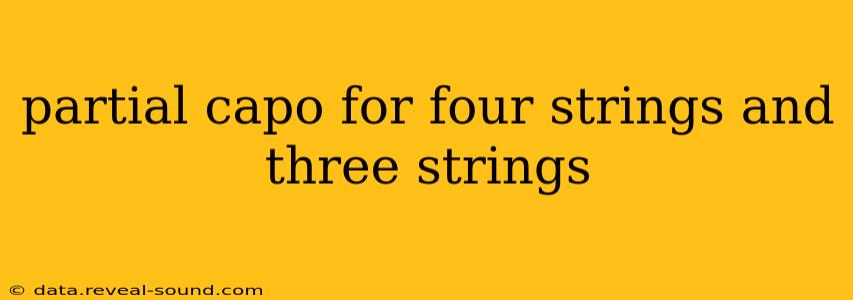The partial capo, a musician's secret weapon, opens up a world of tonal possibilities without the commitment of a full capo. By clamping down on only a selection of strings, you can achieve unique voicings, explore different keys, and add a creative edge to your playing. This guide delves into the techniques and applications of partial capos for both four-string and three-string configurations, providing you with the knowledge to unlock their full potential.
What is a Partial Capo?
A partial capo, unlike its full-bodied counterpart, selectively clamps down on only a portion of the guitar's strings. This allows you to raise the pitch of specific strings while leaving others untouched, resulting in a more nuanced and textured sound compared to using a full capo. It's a versatile tool particularly useful for exploring unique chord voicings and transpositions without the limitations of standard capo placement.
Partial Capo for Four Strings: Techniques and Applications
Using a partial capo on four strings opens a wide range of possibilities. You might choose to capo the top four strings, the bottom four strings, or any combination in between. This technique is incredibly useful for:
-
Altering Chord Voicings: By selectively raising the pitch of certain strings, you can create unique inversions and voicings of familiar chords, adding a fresh perspective to your playing. Experiment with different combinations to discover unique sounds.
-
Creating Open Tunings: Partial capos can effectively mimic the sounds of certain open tunings, giving you access to a wider range of sounds without the hassle of retuning your guitar.
-
Simplifying Chord Shapes: Some chords become easier to play when certain strings are raised in pitch. A partial capo can simplify complex chord shapes, making them more accessible to players of all skill levels.
How to Use a Partial Capo on Four Strings
The best approach is experimentation! There isn't one "right" way. Here are some starting points:
-
Top Four Strings: This is a common starting point, similar to a full capo but allowing the lower strings to retain their original pitch. Experiment with different chord shapes to see how they are affected.
-
Bottom Four Strings: Less common but very effective for creating unique basslines and rhythmic textures. It's ideal for experimenting with different rhythmic patterns and adding a percussive feel.
-
Custom Combinations: Don't be afraid to experiment with capos on the B, G, D, and A strings for example, or other customized combinations to discover unique and unusual chord voicings.
Partial Capo for Three Strings: A Subtle Shift in Sound
Applying a partial capo to only three strings allows for even more subtle changes in tone and voicing. This technique is particularly effective for:
-
Adding Subtle Harmonies: The impact is less drastic than a four-string partial capo, lending itself well to subtle harmonies and melodic embellishments.
-
Creating Unique Textures: By selectively altering the pitch of three strings, you can introduce a unique texture to your playing without significantly changing the overall key or chord structure.
-
Experimental Playing: Three-string partial capos provide a fertile ground for experimental improvisation and exploration.
How to Use a Partial Capo on Three Strings
As with the four-string version, experimentation is key:
-
Adjacent Strings: Capoing three adjacent strings (e.g., the high E, B, and G strings) creates a focused, concentrated effect.
-
Spaced Strings: Capoing three strings spaced apart (e.g., high E, A, and low E strings) generates a more dispersed and complex effect.
-
Focus on specific chord tones: Choose three strings that are critical for your chord voicing, adjusting them for a subtle yet impactful shift.
Frequently Asked Questions
What kind of capo works best for partial capos?
While any capo can be used for partial capos, those with individual clamping mechanisms (often called "clip-on" capos) offer better precision and control over which strings are affected.
Can I use a partial capo on an electric guitar?
Absolutely! Partial capos work equally well on both acoustic and electric guitars.
Are there any disadvantages to using partial capos?
A slight disadvantage is the potential for inconsistent clamping pressure across strings if not properly positioned. Practice and experimentation will ensure the best results.
How do I find the right placement for a partial capo?
Experimentation is key! Start by capering adjacent strings and then try more spaced-out combinations until you find the sound that best fits your musical needs.
Can I use a partial capo in conjunction with a full capo?
Yes, you can use them together for more complex effects. The possibilities are expanded exponentially.
By mastering the art of the partial capo, you can significantly expand your musical palette, creating unique sounds and textures that are both surprising and inventive. Embrace the experimental nature of this technique, and discover the limitless possibilities it unlocks.
